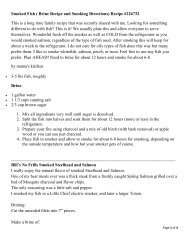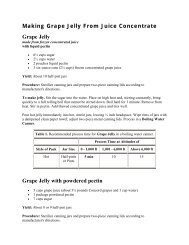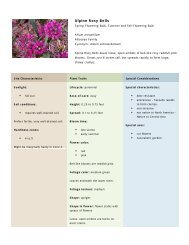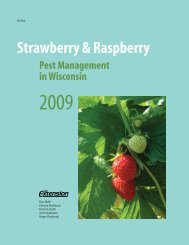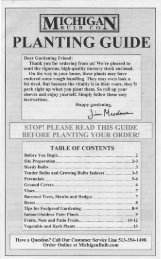as they grow. Bundle the canes and use tw<strong>in</strong>e totra<strong>in</strong> them straight up to the top wire. If canesgrow longer than the top wire, start wrapp<strong>in</strong>g themcarefully around the two tra<strong>in</strong><strong>in</strong>g wires, spread<strong>in</strong>gout canes (Figure 1, page 3, and Figure 2). Thesecanes will fruit next year.Tra<strong>in</strong><strong>in</strong>g the canes to a multiple-wire trellis(Figure 3) or an exist<strong>in</strong>g fence is another option,but tra<strong>in</strong><strong>in</strong>g is more difficult with these methods.Erect blackberries. Erect blackberries produceshort, stiff canes from both the crown andthe roots, thus form<strong>in</strong>g a hedgerow. A simpleknee-high “T” trellis with a 1 1 ⁄2-foot-wide top willsupport the canes. You can make this type of trelliswith rebar. Str<strong>in</strong>g tw<strong>in</strong>e or wire down each sideof the row. Erect blackberries can be tra<strong>in</strong>ed tothe trellis used for trail<strong>in</strong>g blackberries if you aregrow<strong>in</strong>g both types.Semierect blackberries. These plants arevigorous and are easiest to manage on a “doubleT” trellis. Use sturdy end posts, and bury one endso that 6 feet rema<strong>in</strong>s above ground. Use 2x4s forcross arms. Install one cross arm at the top of thepost; this cross arm should be about 4 feet long.Install a 3-foot-wide cross arm about 2 feet belowthe top one. Run high-tensile wire along the rowon each side of the cross arms; you’ll have fourwires.Fertiliz<strong>in</strong>gIn the plant<strong>in</strong>g year, fertilize each plant with½ to 1 oz nitrogen (N), depend<strong>in</strong>g on soil fertility.Use a well-balanced fertilizer such as 16-16-16. Tocalculate how much product to apply, divide thedesired amount of N you need to apply (for example,1 oz) by the percentage of N <strong>in</strong> the fertilizer:1 ÷ 0.16 = 6.3 oz of fertilizer per plant.Do not apply all of the fertilizer at once.Divide the total <strong>in</strong>to thirds and apply the first onethird2 weeks after plant<strong>in</strong>g, the next one-third1 month later, and the f<strong>in</strong>al one-third 1 month afterthe second application. In the above example, youwould apply 2.1 oz of 16-16-16 per applicationper plant (6.3 ÷ 3 = 2.1). Distribute the fertilizerevenly <strong>in</strong> a small area around the young plants.Irrigation and weed controlSupplement ra<strong>in</strong>fall with irrigation as neededto supply about 1 <strong>in</strong>ch of water a week. Keep thearea around plants free of weeds.No fruit is produced <strong>in</strong> the plant<strong>in</strong>g year.A12"12"12"24 to 36"BCFigure 2. Marion blackberry tra<strong>in</strong>ed <strong>in</strong> August. Picturetaken <strong>in</strong> February.Figure 3. Multiple-wire trellis for trail<strong>in</strong>g blackberries, <strong>in</strong>the grow<strong>in</strong>g season (leaves not drawn for clarity): (A)Canes that just bore fruit and will die. (B) Wire guide fornew cane growth. (C) New growth that will bear fruit thefollow<strong>in</strong>g year.4
How much should I fertilize?A good guide for fertilization is to observeplant growth. Primocane leaves should be ahealthy green; a pale green or yellow colormay <strong>in</strong>dicate nitrogen deficiency. Canesshould grow well.Care of establishedplant<strong>in</strong>gsFertiliz<strong>in</strong>gAfter the plant<strong>in</strong>g year, apply fertilizer annuallyto ma<strong>in</strong>ta<strong>in</strong> good growth and leaf color.Apply from 1 to 1 1 ⁄2 oz N per plant (6.3 to 9.5 oz16-16-16 per plant) per year. Divide the total <strong>in</strong>tothirds, and apply one-third at each of three times:(1) when the new primocanes start to grow,(2) at the end of May, and (3) at the end of June.Spread fertilizer over the entire surface of the soil<strong>in</strong> the row. Irrigate right after fertiliz<strong>in</strong>g.If you use manure, apply it <strong>in</strong> late fall orearly w<strong>in</strong>ter to a depth of 2 to 3 <strong>in</strong>ches <strong>in</strong> the row.Reduce the rate of nitrogen fertilizer applied byone-half. Manure applied early <strong>in</strong> the fall maycause blackberries to grow late <strong>in</strong> the season, mak<strong>in</strong>gthem more susceptible to w<strong>in</strong>ter <strong>in</strong>jury.If you use organic mulches for weed control,you may need to apply additional nitrogen fertilizerto assist <strong>in</strong> breakdown of the mulch.IrrigationEstablished blackberry plants need 1 to1 1 ⁄2 <strong>in</strong>ches of water per week from mid-Junethrough late summer. Irrigate when ra<strong>in</strong>fall doesn’tprovide this amount. Plants need more water <strong>in</strong>extremely warm and w<strong>in</strong>dy conditions. To avoidexcessive disease to canes or fruit, it is best to usedrip irrigation or under-canopy spr<strong>in</strong>klers.Weed managementCultivate to control weeds. Cultivate no deeperthan 1 to 2 <strong>in</strong>ches to prevent root damage. You canuse a mulch or landscape cloth (weed mat) aroundtrail<strong>in</strong>g and semierect blackberries to controlweeds. Weed mat is not recommended for erecttypes as it will prevent primocane emergence fromroots.Prun<strong>in</strong>g and tra<strong>in</strong><strong>in</strong>gPrun<strong>in</strong>g <strong>in</strong>structions vary by the type ofblackberry.Trail<strong>in</strong>g blackberryTrail<strong>in</strong>g blackberries produce new primocanes<strong>in</strong> the spr<strong>in</strong>g at the crown of the plant. (No rootsuckers are produced.) After grow<strong>in</strong>g upright for ashort time, these canes turn down and grow alongthe ground.After the first year, there will be fruit<strong>in</strong>g caneson the wire, while new primocanes will grow fromthe crown start<strong>in</strong>g <strong>in</strong> spr<strong>in</strong>g. To avoid damage tonew primocanes, keep them tra<strong>in</strong>ed <strong>in</strong> a narrowrow beneath the bear<strong>in</strong>g canes (Figure 1, page 3).If you have more than one plant, tra<strong>in</strong> all theprimocanes <strong>in</strong> one direction down the row (ratherthan what is shown <strong>in</strong> Figure 1). This will helpprevent primocanes from tangl<strong>in</strong>g and make tra<strong>in</strong><strong>in</strong>geasier. Do not summer prune or tip primocanesdur<strong>in</strong>g the grow<strong>in</strong>g season.After fruit harvest, the floricanes start to die.Unless there is a lot of cane disease, it’s best todelay cutt<strong>in</strong>g off the canes as long as possible.This allows the dy<strong>in</strong>g canes to move nutrients back<strong>in</strong>to the crown and roots, mak<strong>in</strong>g for a healthierplant.In western <strong>Oregon</strong>, it’s best to tra<strong>in</strong> the newprimocanes on the trellis <strong>in</strong> late August. The riskof cold <strong>in</strong>jury <strong>in</strong>creases if you wait to tra<strong>in</strong> <strong>in</strong>September through fall. In eastern <strong>Oregon</strong> andWash<strong>in</strong>gton, leave the primocanes on the ground.In areas with frequent low w<strong>in</strong>ter temperatures,you can try to protect the canes through the w<strong>in</strong>terwith a straw mulch. Then tra<strong>in</strong> the primocanesonto the trellis <strong>in</strong> late February, after any danger ofsevere cold has passed. Tra<strong>in</strong><strong>in</strong>g canes dur<strong>in</strong>g coldtemperatures is not advised, as brittle canes breakeasily.5




